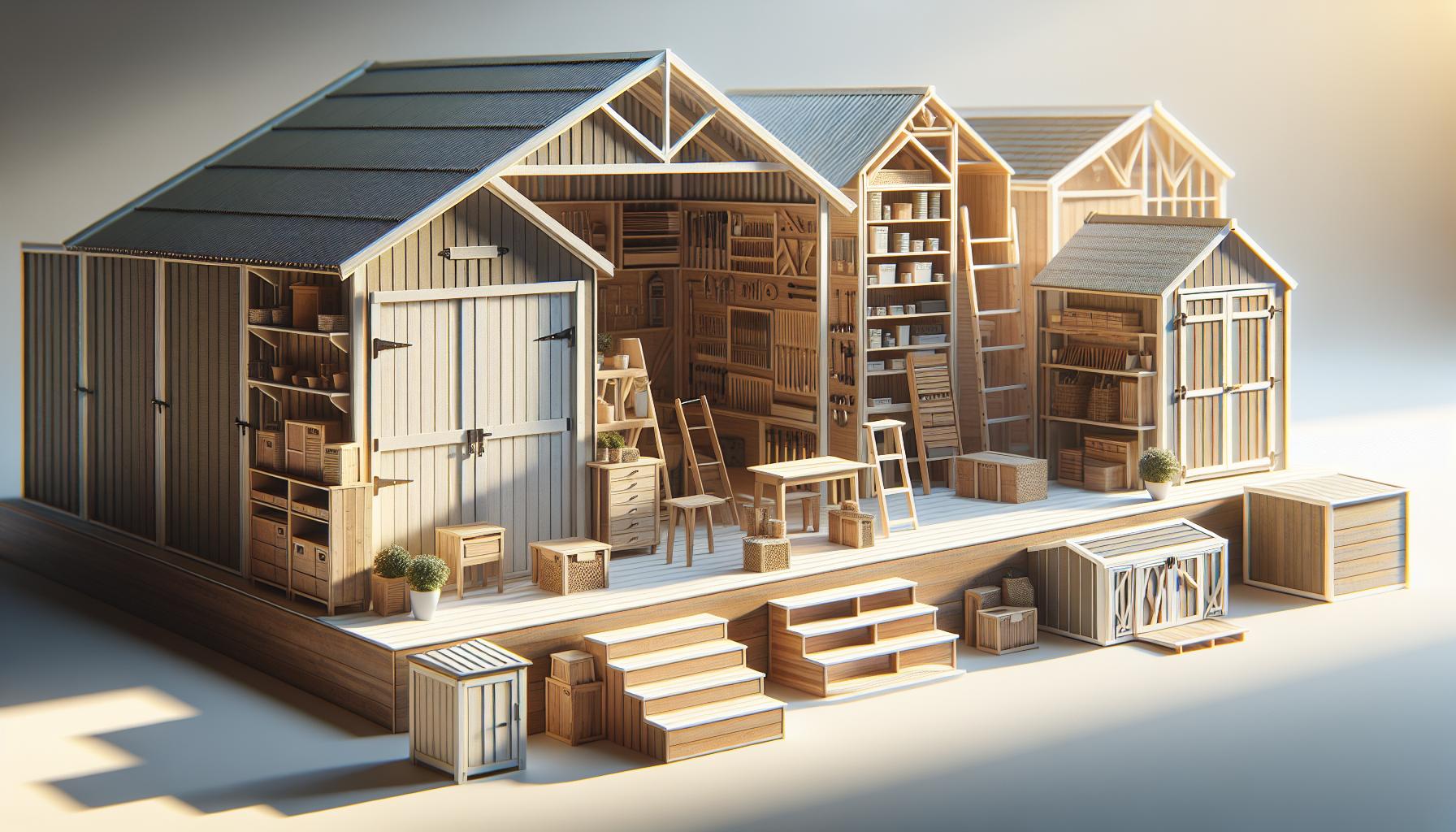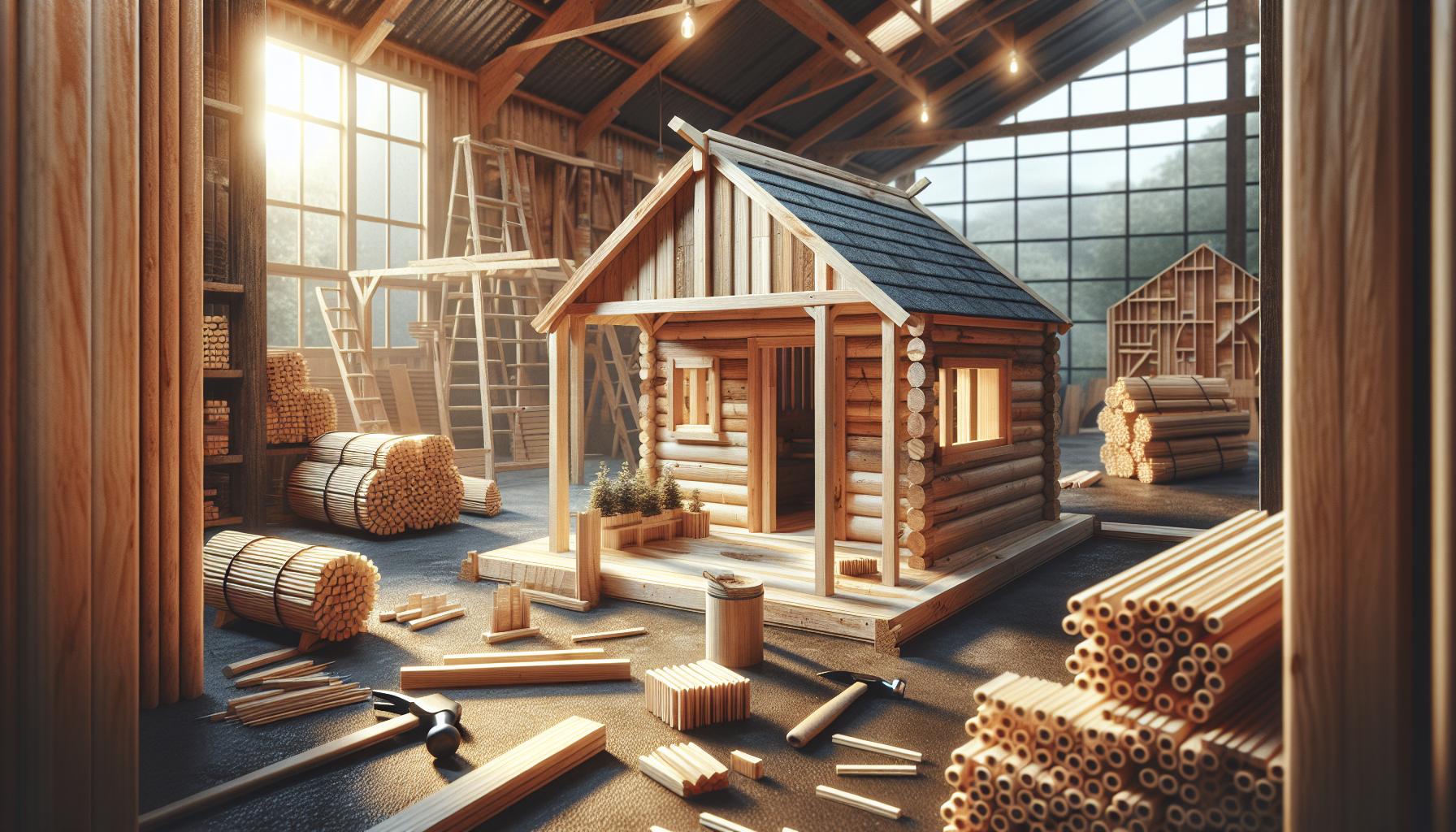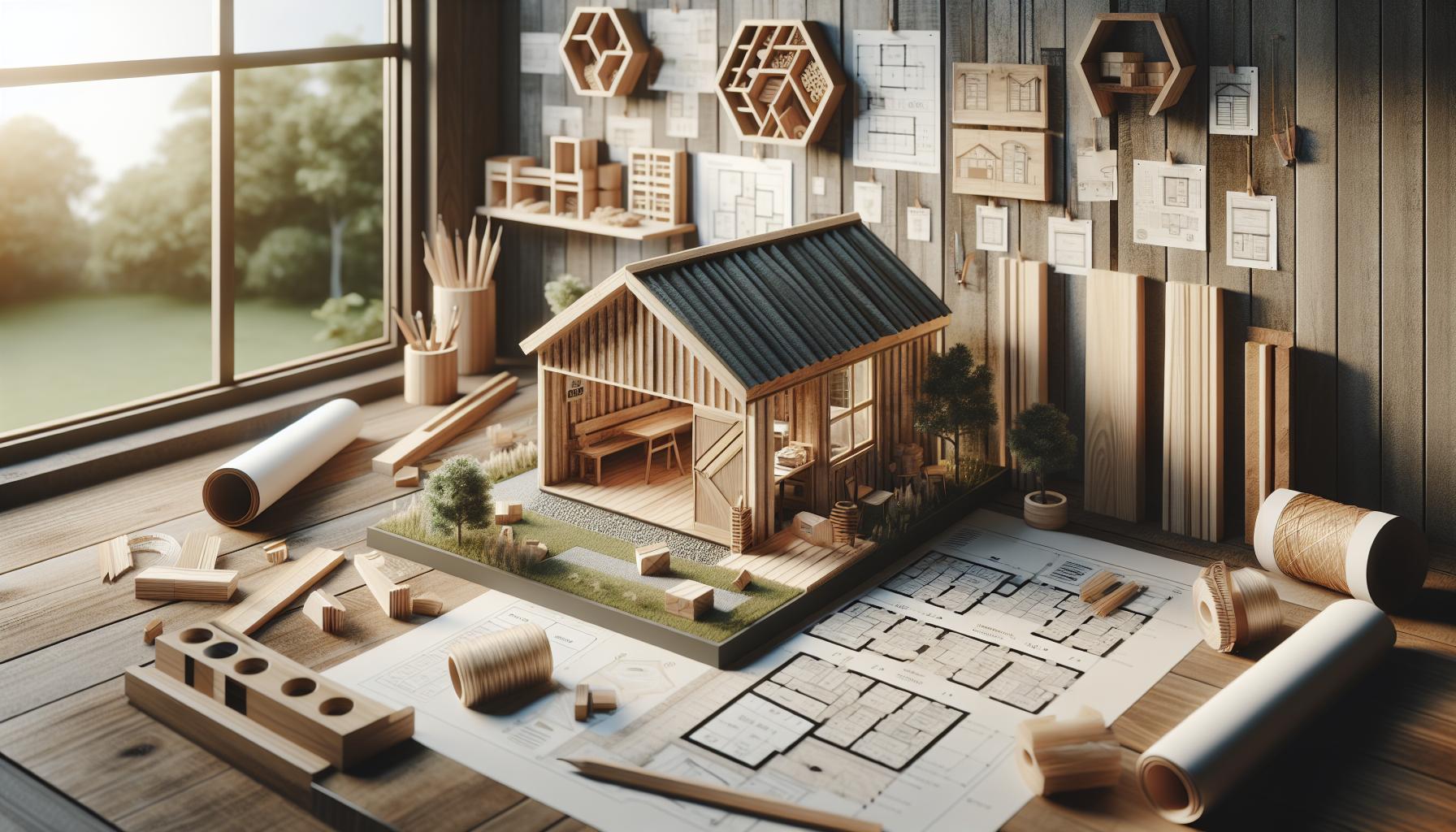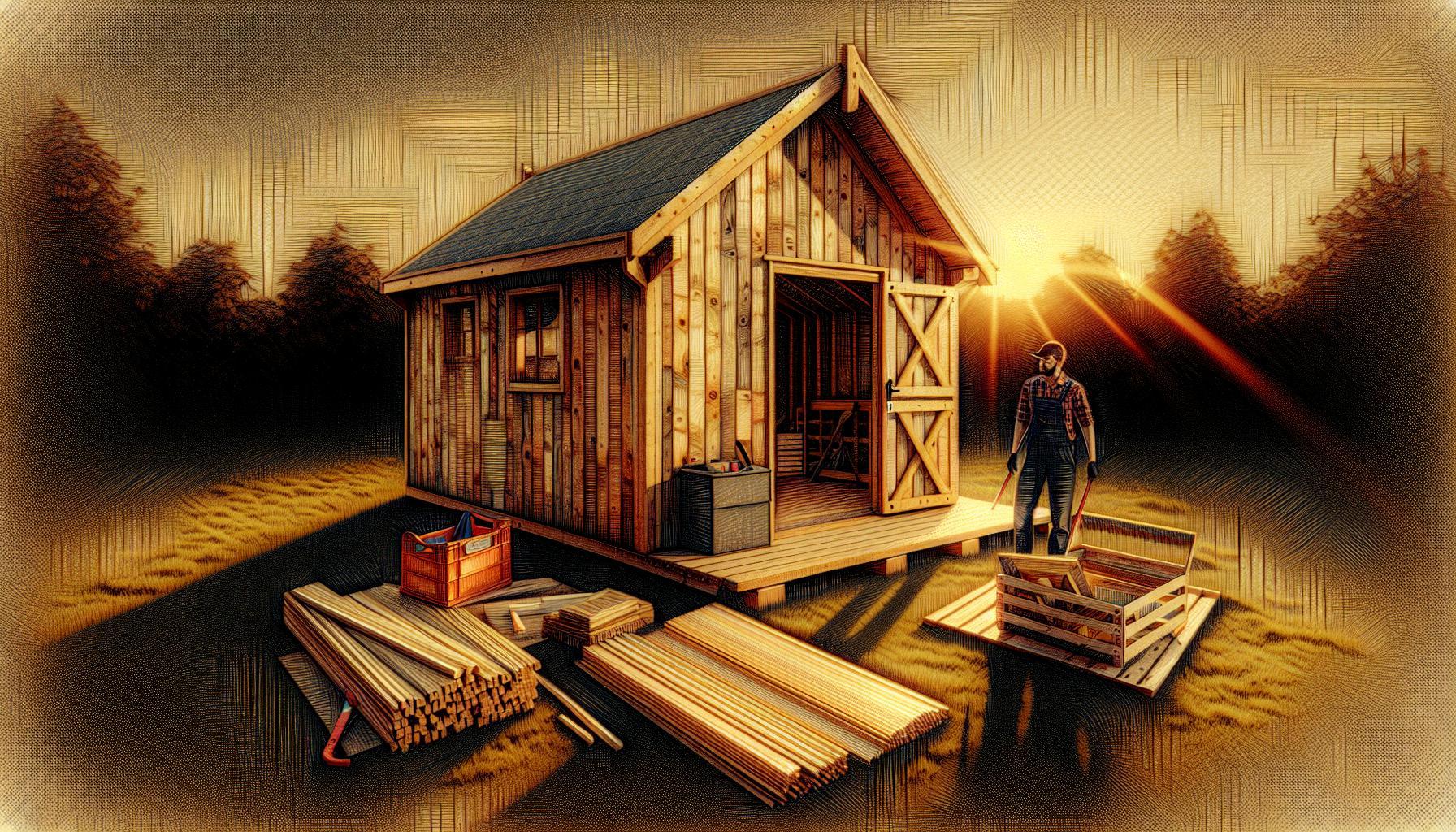Are you considering adding a storage shed to your property but unsure about teh costs involved? Building a storage solution can substantially enhance your space, but pricing can vary widely based on size, materials, and style. This guide breaks down everything you need to know to make an informed decision and budget effectively for your ideal shed.
Understanding the Basics: Factors Influencing Storage Shed Costs
When considering the investment in a storage shed, knowledge truly is power. The cost of building a storage shed can vary significantly based on numerous factors,making it essential to understand what influences these prices. From materials to design choices, each element plays a crucial role in determining how much you’ll end up spending for your storage solution.
Material Choices
The type of material you select for your shed is one of the most importent factors impacting cost. Here are some common materials and their associated price points:
- Wood: Often favored for its aesthetic appeal, wooden sheds tend to range from $1,500 to $5,000 or more, depending on the type of wood and treatment used.
- Metal: Known for durability, metal sheds generally start around $800 and can go up to $2,500, based on size and quality.
- Vinyl: This maintenance-free option ranges between $2,000 and $4,000, making it a solid investment for those looking for durability without the upkeep.
Size and Design Complexity
The dimensions of your shed directly affect the overall cost. A smaller, simple structure may cost substantially less compared to a larger shed that includes more intricate design features. Consider the following variations:
| Size | Estimated Cost |
|---|---|
| 8×10 ft | $1,000 – $2,000 |
| 10×12 ft | $1,500 – $3,000 |
| 12×16 ft | $2,000 – $4,000 |
In addition,the inclusion of features such as windows,shelving,or lofts can further increase the cost. Tailoring the design to specifically meet your needs can maximize both functionality and investment return.
Location and Site Preparation
another variable to take into account is where you plan to place your shed. If your yard is uneven or requires significant site preparation, such as leveling the ground or laying a foundation, this can elevate costs.This process typically ranges from $300 to $1,000, depending on the extent of work needed. Additionally, local building codes and permits can affect pricing; always check local regulations before beginning construction to avoid unexpected fees.understanding how various factors influence the pricing of storage sheds can help you better navigate your purchasing decisions. By keeping these elements in mind—material choices, size and complexity, and location—you can create a more accurate budget and ultimately find a storage solution that meets both your needs and financial parameters.
Material matters: choosing the Right Supplies for Your Shed
When it comes to constructing your ideal storage shed, the materials you choose can significantly impact both the overall cost and the longevity of your structure. Understanding the strengths and weaknesses of various materials not only helps you make an informed decision but also aligns with your budget and intended use.
Types of Materials to Consider
the right supplies for your shed will depend largely on your specific needs, but here are several popular choices to consider:
- Wood: Conventional and aesthetically pleasing, wood sheds provide charm and versatility. However, anticipate higher maintenance costs due to weather exposure.
- Vinyl: Offering durability and little maintenance, vinyl is resistant to rot, rust, and insect damage, making it a great long-term investment.
- Metal: Steel or aluminum sheds score points for strength and security. While they can be more expensive initially,their longevity mitigates maintenance costs.
- Composite Materials: Blending recycled wood and plastic,composites provide an eco-amiable option that resists warping and fading.
Evaluating Material Costs
To help you better understand how various materials influence the overall expenditure, here’s a summarized table illustrating approximate prices for common shed materials:
| Material Type | Cost per Square Foot | Maintenance Level | Longevity |
|---|---|---|---|
| Wood | $15 – $25 | High | 10-15 years |
| Vinyl | $20 – $30 | Low | 25-30 years |
| Metal | $10 – $20 | Medium | 20-30 years |
| Composite | $18 – $35 | Medium | 20-25 years |
Choosing Based on Purpose
Your selection will also depend on how you plan to use your storage shed. For example, if you’re storing garden tools and outdoor equipment, a weather-resistant vinyl or metal shed may suffice, ensuring your items are protected from the elements without requiring extensive upkeep. Conversely, if you’re creating a cozy workshop or hobby space, the aesthetic appeal and structural integrity of wood might be worth the extra investment.
by examining the costs and benefits of each material type, you can align your choice with both your budget and your long-term goals, thus facilitating a decision that not only enhances your outdoor space but also meets your practical needs. Understanding these factors is crucial for anyone looking to delve into the process of constructing a storage shed,thereby creating a functional and durable workspace or storage area that truly fits your lifestyle.
size and Style: How Dimensions Affect Your Budget
When you’re considering the cost of building a storage shed, one of the most critically important factors to keep in mind is the size and style of the structure. These two dimensions will heavily influence your budget, and understanding their implications can help you make informed decisions that align with both your space requirements and financial limits.For instance, it’s common knowledge that a larger shed requires more materials, labor, and sometimes permits, but the style you choose can further complicate or streamline your financial planning.
Understanding size and Its Impact on Costs
The size of your storage shed is frequently enough one of the primary drivers of overall costs. The larger the shed, the more materials like wood, roofing, and flooring you will need, which directly correlates with higher expenses. Thus, before making any cost assumptions, it’s vital to clarify your storage needs. Here’s a speedy reference to help you gauge potential costs based on size:
| Size (Square Feet) | Average Cost Estimate |
|---|---|
| 50-100 sq ft | $1,000 – $2,500 |
| 100-200 sq ft | $2,500 – $5,000 |
| 200-300 sq ft | $5,000 – $7,500 |
| 300+ sq ft | $7,500+ |
As you can see, even a modest increase in size can escalate costs significantly. To maximize your budget efficiently, consider a detailed inventory of the items you plan to store. This will aid in negotiating size requirements to prevent overbuilding.
Exploring Styles and Their Budget Implications
Beyond just size,the style of the shed you choose can dramatically influence costs as well. Such as, a basic lean-to shed is typically less expensive to construct compared to a more intricate A-frame or barn-style shed. The styles can vary from simple designs to elaborate constructions that cater to aesthetics or specific functional requirements, such as garden tool storage or wooden bunkers.
Common shed styles and their potential cost impact include:
- Lean-To Shed: The simplest style, usually cheaper due to fewer materials.
- A-Frame Shed: A classic structure that may require additional materials for the roof.
- Gambrel shed: Designed for more storage space, leading to higher material and labor costs.
- Custom or Specialty Sheds: These unique structures can be costly, depending on design complexity and added features.
Knowing how different styles influence construction costs allows you to budget wisely while still fulfilling your functional and aesthetic desires. Be sure to include any necessary customizations—like shelving, window placements, or insulation—in your overall cost projections to avoid surprises later.
both the dimensions and style of your storage shed play critical roles in determining overall costs, aligning how much you plan to invest with your storage needs and design aspirations. understanding these elements sets the groundwork for navigating the pricing landscape effectively, as emphasized in our thorough guide on how much to build a storage shed across various sizes and styles.
DIY vs.Hiring a Pro: Evaluating Your Options and Costs
When considering the construction of a storage shed,the decision between taking on a DIY project or hiring a professional can significantly impact both your budget and the overall outcome. Each option has its own set of advantages and challenges, making it essential to evaluate your skills, resources, and requirements before proceeding. Understanding the nuances of these choices can help ensure your shed meets your functional needs while staying within financial limits.
### Cost Implications
Determining the cost of building a storage shed involves assessing both direct expenses and potential hidden costs. Here’s a breakdown of what investing in DIY vs. hiring a professional typically looks like:
| Expense Type | DIY | Hiring a Pro |
|---|---|---|
| Materials | Cost of lumber, fasteners, and other materials (typically $1,000 – $2,500) | Higher material costs due to markup or specialized services (typically $1,500 – $3,500) |
| Labor | None, assuming you do the work yourself | Professional labor costs (ranging from $500 – $1,500, depending on project complexity) |
| Time | Time-consuming; building the shed could take several weekends | Less time-consuming; professionals can often complete the project in a few days |
| Permits | May need to apply for these yourself, perhaps adding to the time | usually handled by the contractor, which can save you effort |
### Skill Level Consideration
Its important to realistically assess your skills before jumping into a DIY project. For those with a background in carpentry or construction, building a storage shed might potentially be a rewarding endeavor that allows for personal creativity and cost savings. However, if you’re inexperienced, the potential for costly mistakes can outweigh the savings.
Conversely, hiring a professional often guarantees superior workmanship, especially for complex designs or larger structures. Experienced contractors can provide valuable insights on building codes, materials, and best practices, potentially enhancing the longevity and safety of your shed.Engaging a professional may require a larger initial financial commitment,but it often pays off in the durability and aesthetic quality of the finished product.
### Assessing Your Time and Needs
Beyond financial considerations, reflect on your time availability and the urgency of the project. If you have limited time or need the shed completed quickly—perhaps for an upcoming event or seasonal storage needs—hiring a pro could be the wiser choice. on the other hand, if you savor DIY projects and can spare the time, constructing the shed yourself not only can save money but also yield a sense of accomplishment.
Ultimately, deciding between a DIY project or hiring professionals for your storage shed construction boils down to balancing cost, skill, and time. Whether you choose to embark on this journey solo or enlist expert help, ensuring that you keep tabs on how much to build a storage shed—considering all sizes and styles—will help you make an informed decision tailored to your unique circumstances.
Additional features: Customizing Your Shed Without Breaking the Bank
Creating a personalized storage shed doesn’t have to mean spending a fortune. In fact, with a few clever strategies and a bit of creativity, you can customize your shed while keeping costs low. Whether you’re looking to enhance functionality, improve aesthetics, or add a touch of your personality, there are numerous features that can be integrated without straining your budget.
Maximize Functionality with Budget-Friendly Features
When considering how much to build a storage shed, it’s crucial to think about what features will truly enhance its usability. Here are a few suggestions to optimize your space without significantly increasing costs:
- Adjustable Shelving: Rather of fixed shelves, invest in adjustable shelving units. This allows you to customize the space based on your storage needs over time.
- Pegboards: A simple pegboard on the wall provides a great organizational tool for hanging tools and smaller items, keeping everything accessible and visible.
- Dual-Purpose Furniture: Consider adding benches that double as storage. You can build a simple wooden bench that has a hollow compartment beneath,providing seating and storage in one.
Eye-Catching aesthetics on a Budget
Enhancing the appearance of your shed doesn’t necessarily require high-end materials. Here are some economical ways to elevate its charm:
- Paint and Stain: A fresh coat of paint or stain can change the entire look of your shed. Choose colors that blend well with your home or garden for a cohesive aesthetic.
- Decorative Hardware: Swapping out standard door handles and hinges for more ornamental hardware can give your shed a custom look. This upgrade is often inexpensive but makes a significant impact.
- Window Boxes and Planters: Adding window boxes filled with cheerful flowers or greenery can bring life to your shed’s exterior without requiring extensive renovations.
Understanding the Real Costs
When diving into features and enhancements, being aware of costs can help maintain your budget. Below is a simple breakdown of common additions and their approximate costs that can fit within the overall pricing framework outlined in “How Much to Build a Storage Shed: Pricing Guide for All Sizes & Styles.”
| Feature | estimated Cost |
|---|---|
| Paint/Stain (per gallon) | $20 – $40 |
| Adjustable Shelving Kit | $40 – $100 |
| Pegboard Panel | $15 – $30 |
| Decorative Hardware (per piece) | $5 – $30 |
| Window Boxes | $10 – $50 |
These options allow you to adapt your shed to your needs while managing costs effectively. With a little ingenuity and planning, customizing your shed can be an enriching experience that enhances both functionality and style without veering into extravagance.
Planning for permits: Navigating Local Regulations
Understanding local regulations and obtaining the necessary permits is a crucial step in the process of building a storage shed, as it can significantly influence both your budget and timeline. Many homeowners underestimate the complexity of these regulations, which can vary widely depending on your location. Before diving into the exciting aspects of design and construction, having a clear grasp of the local rules can save you from costly mistakes and ensure your storage solution is compliant and secure.
Why Permits Matter
Obtaining permits is not just a bureaucratic hurdle; it is indeed essential for ensuring the safety and legality of your project. Failure to secure the appropriate permits can lead to fines, forced removal of your shed, or even legal action. It’s estimated that roughly 30% of shed constructions are non-compliant with local building codes, which can result in significant headaches down the road. Additionally, permits help to uphold community standards and protect property values.
Steps to Navigate Local Regulations
To ensure you are navigating the permitting process smoothly, follow these actionable steps:
- Research Local Building Codes: Start by visiting your city or county’s website, where you can usually find a section devoted to building regulations. Key aspects to look for include yard setbacks, height restrictions, and size limitations.
- Determine Required Permits: Depending on the size and type of the shed,you may need a building permit,a zoning permit,or even site plan approval. Some municipalities have exemptions for small sheds (frequently enough under 100 square feet),but confirm this with local authorities.
- Consult with Your Neighbors: It’s an excellent idea to discuss your plans with neighbors who might be affected by the shed’s placement. While not mandatory, this practice can help maintain good relationships in your community and may provide insight into local regulations.
- Prepare Documentation: When applying for a permit, you’ll typically need to submit plans that detail dimensions, materials, and site placement. Consider hiring a professional if you’re unsure about the details needed for a comprehensive submission.
- Keep Records: Once you receive your permits, keep all records safely stored. This will be vital should you ever need to prove compliance, especially if you decide to sell your home.
permit Costs to Consider
Understanding the potential costs associated with permits is essential when budgeting for your shed.Permit fees can vary significantly based on location and the scope of your project. Here’s a simple table illustrating typical fee ranges based on shed size:
| Size of Shed | Typical Permit Fee |
|---|---|
| Under 100 sq.ft. | $0 – $100 |
| 100 – 200 sq. ft. | $100 – $200 |
| Over 200 sq. ft. | $200 – $500+ |
Being well-informed about the permitting process allows you to build your storage shed more confidently, ensuring that you comply with all local regulations and avoid unexpected complications.Remember, thorough planning and a proactive approach to securing permits can make the construction process smoother and more enjoyable.
Maintenance and Longevity: Investing for the Future
Maintaining your investment in a storage shed goes beyond its initial construction; it’s a commitment to ensuring it remains functional and visually appealing for years to come. Just as you wouldn’t neglect the upkeep of your home, your shed deserves the same level of care. A well-maintained shed not only retains its value but also saves you money in the long run by preventing costly repairs or replacements.
Routine maintenance Tips
To keep your storage shed in pristine condition, consider implementing a regular maintenance routine. Here are some essential tasks to include:
- Inspect for Damage: Regularly check the roof, walls, and foundation for any signs of wear or damage. Look for leaks, cracks, or rot that could compromise the structure.
- Clean Gutters and Drains: ensure that gutters and drainage systems are free from debris. Poor drainage can lead to water accumulation and structural issues.
- Repaint or Restain: Depending on the material, it’s advisable to repaint or restain your shed every few years to protect it from the elements. This not only enhances appearance but also adds a layer of protection against moisture and UV rays.
- Check Hardware and Locks: ensure that hinges, locks, and latches are functioning correctly. Replace any that are rusted or broken to maintain security.
Planning for Longevity
Investing in high-quality materials from the outset can significantly extend the lifespan of your storage shed.While the initial costs may be higher when considering factors from the ‘How Much to Build a Storage Shed: Pricing Guide for All Sizes & Styles’, the return on investment becomes evident in reduced maintenance and replacement costs. Here’s a comparison of materials that can affect long-term durability:
| material | Durability | Maintenance Level | Cost |
|---|---|---|---|
| Wood | High (if treated) | Medium (requires painting/staining) | Moderate |
| Vinyl | Very High | low (easy to clean) | Higher |
| Metal | High (resistant to rot) | Medium (rust prevention needed) | Moderate |
By choosing the appropriate materials based on your specific needs and climate,you can ensure your shed stands the test of time. Additionally, consider the specific features of your shed that might require extra attention, such as windows for ventilation or shelves for association, as they may influence both functionality and maintenance.
Through proactive care and the right investment decisions, your storage shed will not only fulfill its purpose but also become a valued asset that enhances your property’s overall appeal and utility for many years ahead.
Faq
How much does it cost to build a storage shed?
Building a storage shed can cost between $1,000 and $5,000, depending on size, materials, and design. Basic models are more affordable, while custom features increase costs significantly.
Factors like location and labor can also affect the final price. For a detailed overview, check the Pricing Guide for All Sizes & Styles to get a sense of what fits your budget.
What is included in the price to build a storage shed?
The price to build a storage shed typically includes materials, labor, and foundation costs. You’ll pay for wood, roofing, flooring, and possibly windows and doors.
Additionally, consider costs for permits or other municipal regulations that might apply in your area. Understanding these components will help you budget effectively for your shed project.
How can I save money when building a storage shed?
To save money when building a storage shed, consider DIY options and using less expensive materials. Repurposed materials can reduce costs significantly.
Planning the size and complexity of your shed can also help; simpler designs require less labor and fewer materials. For more budget-friendly ideas, explore the Pricing Guide for All Sizes & Styles.
What size storage shed do I need?
The size of the storage shed you need depends on what you plan to store. Standard options range from 8×10 feet to 12×20 feet, accommodating various storage needs.
Consider factors such as outdoor space, zoning laws, and future storage requirements. An organized approach can save time and effort in the long run.
Why does the price of building a storage shed vary?
The price of building a storage shed varies due to factors like material choices, design complexity, and local labor rates. High-quality materials such as cedar or vinyl can significantly increase costs.
Seasonality also plays a role; prices may fluctuate based on demand. Thorough research will help you make informed choices aligned with your budget and needs.
Can I build a storage shed without a permit?
you may be able to build a storage shed without a permit, but this depends on local regulations.Many areas allow sheds below a certain size to be built without permits.
However, it’s crucial to check your local building codes beforehand.Failing to secure permits can lead to fines or removal of the structure.
What are the most popular styles of storage sheds?
The most popular styles of storage sheds include gable, barn, and lean-to designs, each offering unique aesthetics and functional benefits.
Gable sheds are frequently enough preferred for their ease of construction, while barn-style sheds offer additional loft space. Explore these styles to find the one that best suits your needs.
to sum up
building a storage shed is a project that can be both rewarding and practical, whether you choose a basic design or something more elaborate. We’ve explored various factors that influence the cost, including size, materials, and style, giving you a comprehensive pricing guide to work with.
Remember, every DIY journey has its challenges, but with careful planning and the right resources, you can overcome any obstacles. Take your time to assess your needs,budget,and skills,and don’t hesitate to seek advice or additional data as required.
As you embark on your shed construction, embrace the learning process and focus on achieving quality craftsmanship. Each step you take brings you closer to your goal, and the satisfaction of building your own space is well worth the effort.
We encourage you to delve deeper into your options and consider how you can customize your shed to suit your specific needs. Whether you need additional storage, a workshop, or a creative space, the possibilities are endless. Happy building, and may your storage solutions be as sturdy and stylish as you envision!









